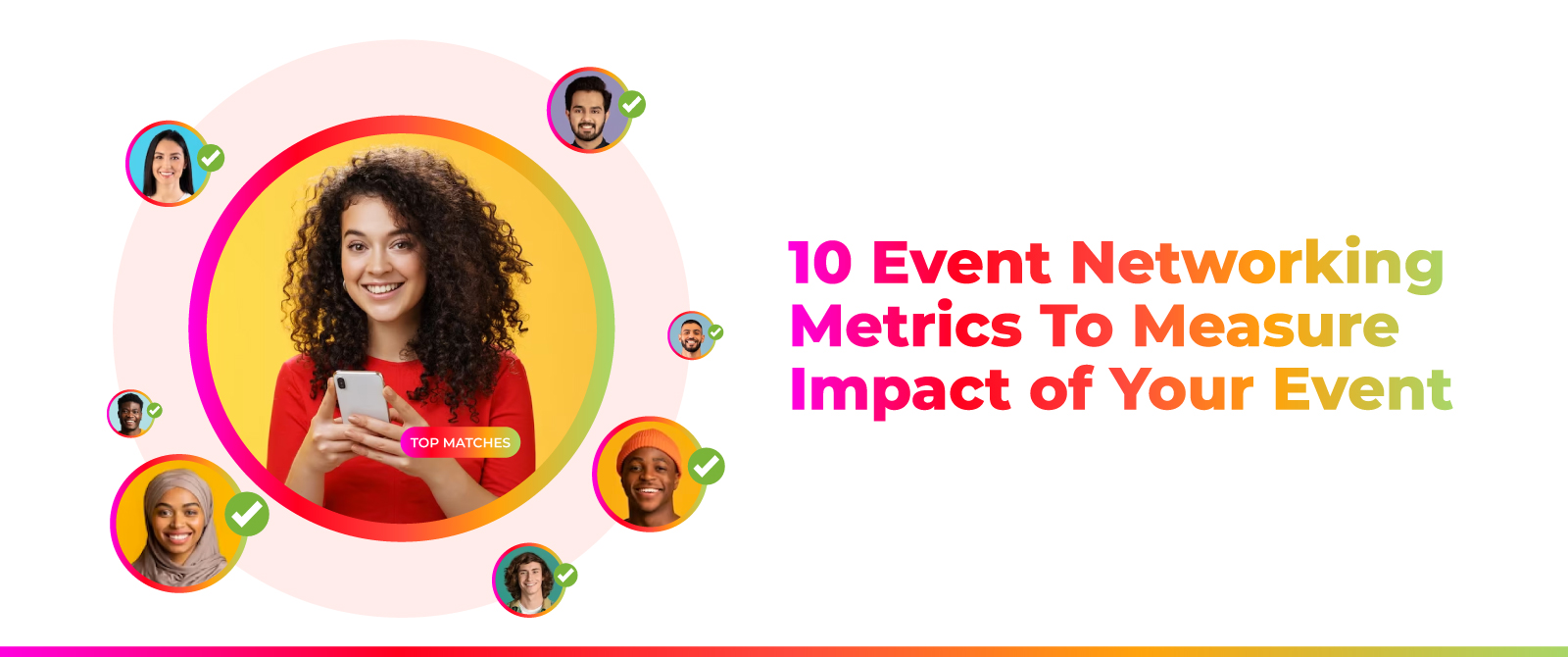Whether it’s a conference, trade show, or virtual summit, measuring the impact of your networking efforts is essential for refining strategies and achieving your goals. In this comprehensive guide, we’ll explore significant event networking metrics that can empower you to succeed in building meaningful connections and unlocking new opportunities.
1. Attendance and Engagement Rates:
The success of any networking event begins with attendance. Tracking the number of participants and their engagement levels provides insights into the event’s overall impact. High attendance coupled with active participation signifies a successful networking opportunity, while low engagement may indicate the need for adjustments in content, format, or marketing strategies.
2. Connection Requests and Acceptance Rates:
In the digital age, connection requests serve as a valuable indicator of interest and potential collaboration. Monitoring the number of connection requests sent and accepted on platforms like LinkedIn or other event-specific apps provides a tangible measure of your networking reach and effectiveness. A higher acceptance rate reflects a successful networking strategy and the creation of genuine connections.
3. Lead Generation and Conversion Rates:
Events are powerful tools for lead generation, making it essential to track the number of leads generated during and after the event. Evaluate the quality of leads by analyzing their relevance to your goals and industry. Conversion rates, measured by the number of leads that turn into tangible opportunities, provide a deeper understanding of your event’s impact on business development.
4. Session and Booth Traffic:
For events with multiple sessions or exhibition booths, monitoring the traffic each area receives is critical. High footfall indicates strong interest, while low attendance may prompt a reevaluation of content, speaker selection, or booth design. Analyzing traffic patterns helps identify popular topics and areas of interest, guiding future event planning decisions.

5. Social Media Mentions and Impressions:
The online conversation surrounding an event extends far beyond its physical or virtual boundaries. Tracking social media mentions, hashtags, and impressions provides a broader perspective on the event’s reach and impact. Positive sentiment in social media discussions can contribute to a successful post-event narrative and enhance your overall networking strategy.
6. Post-Event Surveys and Feedback:
Post-event surveys and feedback are essential components of refining networking strategies and improving future events. These surveys offer a direct line of communication with participants, providing invaluable insights into attendee satisfaction, preferences, and areas needing improvement. By analyzing feedback, organizers can identify what worked well and what didn’t, allowing for targeted adjustments to enhance overall event experiences. This data-driven approach enables organizers to tailor networking initiatives, session content, logistical arrangements, and technology integration to better meet participant expectations. Furthermore, actively seeking and acting upon feedback demonstrates a commitment to continuous improvement, fostering stronger participant engagement and building a positive brand reputation within the industry. Event Networking App can help you to conduct post event surveys and feedback. Ultimately, post-event surveys serve as a catalyst for refining networking strategies, optimizing event experiences, and driving ongoing success in organizing impactful and engaging events.
7. Return on Investment (ROI):
Understanding the financial impact of your networking efforts is crucial for assessing the overall success of an event. Calculate the return on investment by comparing the total cost of participation to the revenue or value generated. This includes both tangible outcomes, such as new business deals, and intangible benefits, such as increased brand visibility or improved industry reputation.
8. Networking App Usage:
Many events leverage dedicated networking apps to facilitate connections and information exchange among participants. Analyzing app usage metrics, such as the number of messages sent, meetings scheduled, and profile views, provides insights into the effectiveness of the networking platform. This data aids in refining the app’s features and optimizing its role in enhancing event networking.
9. Long-Term Relationship Building:
Successful networking goes beyond the immediate event, focusing on the establishment and growth of long-term relationships. Track the continuity of connections made during an event by monitoring post-event communication, collaborations, and ongoing engagement. The ability to cultivate relationships over time is a key indicator of sustained networking success.
10. Diversity and Inclusion Metrics:
Evaluate the diversity and inclusivity of your event by tracking metrics related to participant demographics. Measure the representation of different industries, roles, and backgrounds among attendees. A diverse networking environment fosters a rich exchange of ideas and perspectives, contributing to a more vibrant and successful event experience.
Why it is Important to Track Event Networking Metrics
Tracking event networking metrics is essential for several reasons, each contributing to the overall success and effectiveness of your networking efforts. Whether you are organizing an event or participating as an attendee, understanding and analyzing these metrics can provide valuable insights and guide future strategies. Here are some key reasons why it is important to track event networking metrics:
Measure Effectiveness:
Quantify Impact: Metrics help quantify the impact of your networking efforts. By tracking various aspects such as attendance rates, engagement levels, and lead generation, you can assess how well your event resonated with participants and achieved its objectives.
Refine Strategies:
Identify Strengths and Weaknesses: Metrics highlight both successful and underperforming aspects of your event. Knowing what worked well enables you to reinforce those strategies while understanding weaknesses allows for targeted improvements in content, logistics, or engagement methods.
Optimize Resource Allocation:
Allocate Budget Efficiently: Events often require significant financial investment. Tracking metrics, particularly return on investment (ROI), helps in evaluating the cost-effectiveness of your networking activities. This information enables you to allocate resources more efficiently in the future.
Enhance Participant Experience:
Tailor Content and Format: Metrics related to session attendance, booth traffic, and feedback surveys provide insights into what participants find engaging. This information allows you to tailor future events to better meet the needs and preferences of your audience, enhancing their overall experience.
Quantify Networking Reach:
Understand Reach and Influence: Metrics such as social media mentions, connection requests, and app usage metrics quantify your networking reach. Understanding how widely your event is discussed and how many meaningful connections are established helps gauge your influence within the professional community.
Drive Continuous Improvement:
Feedback Loop: Post-event surveys and feedback mechanisms establish a valuable feedback loop. By consistently collecting input from participants, you create a mechanism for continuous improvement, ensuring that each successive event builds upon the lessons learned from previous ones.
Strategic Decision-Making:
Informed Decision-Making: Access to data-driven insights facilitates informed decision-making. Whether you’re deciding on event formats, choosing speakers, or selecting networking platforms, metrics guide your choices based on past performance and the specific needs of your target audience.
Foster Long-Term Relationships:
Cultivate Long-Term Connections: Metrics related to long-term relationship building help you understand the lasting impact of your networking efforts. Tracking ongoing engagement and collaboration post-event emphasizes the importance of cultivating relationships beyond the immediate networking environment.
Adapt to Changing Trends:
Stay Relevant: The events landscape evolves over time, with new technologies and trends shaping networking experiences. By tracking metrics, you can adapt to changing preferences and expectations, ensuring that your networking strategies remain relevant and effective in a dynamic professional environment.
Final Words
Effective networking is a multifaceted endeavor that requires careful planning, execution, and evaluation. By incorporating these ten event networking metrics into your strategy, you can gain valuable insights that go beyond mere attendance numbers. Whether you’re organizing an event or participating as an attendee, these metrics empower you to refine your approach, build meaningful connections, and ultimately succeed in the competitive landscape of professional networking. As the events landscape continues to evolve, leveraging these metrics will be crucial in adapting and optimizing your networking strategy for future success.
FAQs
Event networking metrics are quantitative measurements used to assess the effectiveness and impact of networking activities during an event. These metrics help organizers understand how well attendees are connecting, collaborating, and engaging with each other. They are essential for evaluating the success of networking strategies and overall event objectives.
Some key metrics include the number of connections made, the level of attendee engagement, the volume of shared content, and the quality of interactions. Tracking these metrics can provide insights into the success of your networking initiatives and help you gauge the overall impact on participants.
Quality interactions can be measured by evaluating the depth and relevance of conversations, the exchange of business cards or contact information, and the extent to which participants follow up post-event. Surveying attendees on their perceived value of networking opportunities can also provide qualitative insights.
Attendee engagement is a crucial metric, reflecting the level of interest and participation in networking activities. Metrics such as session attendance, active participation in discussions, and feedback on networking features within the event app can help assess overall engagement.






